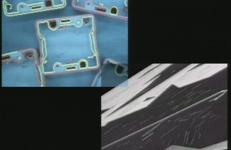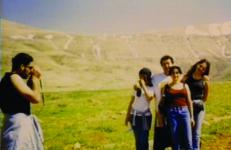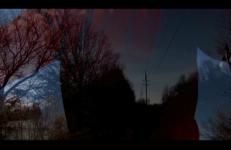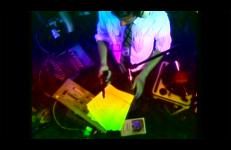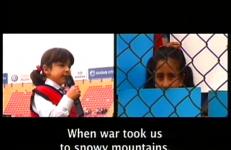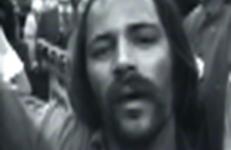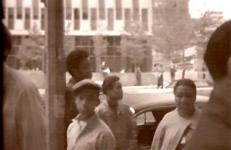"How can the distinction between "man" and "machine" still be made given today's technology? In modern weapons technology the categories are on the move: intelligence is no longer limited to humans. In Eye/Machine II, Farocki has brought together visual material from both military and civilian sectors, showing machines operating intelligently and what it is they see when working on the basis of image processing programs. The traditional man-machine distinction becomes reduced to "eye/machine", where cameras are implanted into the machines as eyes.
Politics
“The third part of the Eye/Machine cycle structures the material around the concept of the operational image. These are images which do not portray a process, but are themselves part of a process. As early as the Eighties, cruise missiles used a stored image of a real landscape, then took an actual image during flight; the software compared the two images, resulting in a comparison between idea and reality, a confrontation between pure war and the impurity of the actual. This confrontation is also a montage, and montage is always about similarity and difference.
Artist Rabih Mroué looks back at old audio recordings, which were made by him and his parents to be sent as audio letters to his brother while he studied abroad. The old recordings become the site of a political critique of the packaged values of communism, resistance and martyrdom.
This title is only available on Radical Closure.
In Fagtasia Solstice, Brenda and Glennda attend a Radical Faerie event in New York City to commemorate the Summer Solstice. Through interviews with Faeries and footage of their walk across the Brooklyn Bridge, the group proposes to reclaim the city as a safe space for queer people, and discuss reorienting queer consciousness toward spirituality.
An episode of The Brenda and Glennda Show, hosted by Brenda Sexual and Glennda Orgasm. Featuring the Radical Faeries. Thanks to Julie Clark and Dana Nasrallah.
Failing Up describes career advancement despite bad decisions, bankruptcies, and intellectual mediocrity. In this short film, the Manhattan real estate holdings of the King of Failing Up are catalogued and synced to a soundtrack that suggests how it feels to be one of his subjects.
Whip pans, zooms, lens twists, and bursts of stop-frame animation transform eight minutes of borrowed audio from Home Alone 2 (a film that features a cameo of the current US President) into a political work of slapstique concrete.
A woman recounts her story of the mass exodus of Palestinians from Jerusalem. Beginning with the arrival and ending with the departure, the tale moves backwards in time and through various landscapes. The events are neither undone nor is the story untold; instead, Farther than the eye can see traces a decaying experience to a place that no longer exists.
Fences Make Senses re-stages and interrogates international barriers and borders using the bodies of non-refugees. Through a series of rehearsals, Barber aims to have privileged bodies experience the themes, situations, and ideas that refugees frequently face. This video was produced in response to the great number of documentaries the artist witnessed that interviewed the unfortunate in their impoverished conditions. Kept in limbo and squalor for years, these refugees are casually disliked by their "host" country.
Broadcasters across Ireland and Britain have entered into a blackout strike. The workers are transmitting a programme bringing censored voices back onto the airwaves.
"In the late 1980s, as violence continues in the north of Ireland, censorship is increasingly being enforced on British and Irish television. In response, broadcasters have entered into a blackout strike, occupying several stations and transmitting a programme bringing censored voices back onto the airwaves."
"On January 22, 1987 an unjustly convicted Budd Dwyer grasped onto the pages of his final speech as Pennsylvania's State Treasurer before shooting himself in front of news cameras. Our current year of armageddon, recession, and occupation resonates as a fitting time to step into Budd's shoes (and perhaps others who sought freedom the same way.) I set up a mini news conference with antiquated, glitchy analog cameras, mixers, players, and decks with the goal of recording Budd's speech in one take.
John Smith’s Flag Mountain records a vast flag, the insignia of the Turkish Republic of Northern Cyprus, painted onto the side of the Kyrenia mountains overlooking Nicosia, the divided capital of the former island nation. The flag, situated in what is officially understood under international law to be 'Turkish occupied' northern Cyprus, is accompanied by the legend 'Ne mutlu Türküm diyene' ('How happy is he who can say “I am a Turk”').
"The Flag is the second part of a video series about the state-controlled national day ceremonies of the Turkish Republic. Shot during the April 23rd Children’s Day celebrations, which mark the establishment of the new Turkish Parliament, and hence the official demise of the Ottoman Empire back in 1920, this split screen film documents a pompous patriotic performance devised by elders to be performed by children.
A film for high school students and their teachers about the history of the Viet Nam War, composed of just photographs from that war, narration and, to help us through a damned disheartening story, lots of the Bach Suite for Solo Cello #1 in G.
To read the accompanying curriculum guide click here.
Forbidden to Wander chronicles the experiences of a 25-year-old Arab American woman traveling on her own in the occupied territories of the West Bank and Gaza Strip during the summer of 2002. The film is a reflection on the complexity of Palestinian existence and the torturously disturbing “ordinariness” of living under constant curfew. The film’s title reflects this, as the Arabic words used to describe the imposed curfew “mane’ tajawwul” literally translate as “forbidden to wander”.
This installation is based on the re-enactment of Franz Kafka’s allegory "Before the Law", interpreted live over a telephone line by Katharine Gun. Gun was a translator (specializing in Chinese to English translations), working with the British secret service, who chose to leak information compromising the U.S. and U.K. governments in their push for a U.N. resolution for the invasion of Iraq.
TVTV's inside view of the 1972 Republican National Convention made broadcast history. While network cameras focused on the orchestrated renomination of Richard Nixon, TVTV's rag-tag army of guerrilla television activists turned their cameras on to the cocktail parties, anti-war demonstrations, hype and hoopla that accompanied the show.
Framed is the second installment of the longer piece, Video Bites: Triptych for the Turn of the Century. Offering a series of visual metaphors discussing the ubiquity of the "frame" in contemporary life, Braderman uses her trademark chroma-key to juxtapose exterior landscapes with television clips, advertisements, and news footage.
Framed originally premiered as part of Video Bites: Triptych for the Turn of the Century in 1998; it was re-edited in 2017. Braderman co-directed Framed with Dana Master.
In the words of activist Dhoruba Bin Wahad, “Historical and social events are subject to almost instant censorship by those who have better access and control over the medium of communication. It is important that there exist people skilled in the use of the technological instruments of communication who will seek out the real truth behind the headlines and tell it for all to see, know, and hear.”
In the words of activist Dhoruba Bin Wahad, “Historical and social events are subject to almost instant censorship by those who have better access and control over the medium of communication. It is important that there exist people skilled in the use of the technological instruments of communication who will seek out the real truth behind the headlines and tell it for all to see, know, and hear.”
Rare footage of a September 1970 rally honoring the late Fred Hampton, Deputy Chairman of the Illinois chapter of the Black Panther Party. One of the speakers leads the audience in a call and response.
Free Society is a short experimental music video that juxtaposes images of police harrassment in the U.S. with images of the military quelling revolutionary opposition. Includes comments from televangelist Jerry Falwell.
This title is also available on Paul Garrin Videoworks: Volume 1.
In From Fagtasia to Frisco, Brenda and Glennda report from Fagtasia, an event honoring the Summer Solstice in New York organized by the Radical Faeries. Through interviews with Faeries and footage of their walk across the Brooklyn Bridge, the group proposes to reclaim the city as a safe space for queer people, and discuss reorienting queer consciousness toward spirituality.
This two-part video Gender Cruise on the Circle Line involves Brenda and Glennda leading a group of drag queens, drag kings, and other gender nonconforming people on a three-hour ride on the Circle Line boat around Manhattan.
The two-part video Gender Cruise on the Circle Line involves Brenda and Glennda leading a group of drag queens, drag kings, and other gender nonconforming people on a three-hour ride on the Circle Line boat around Manhattan.
In the wake of Lord of the Universe, TVTV planned to cover the impeachment of Richard Nixon, but, unfortunately, Nixon resigned. The group made a ninety-degree turn to covering the “first hundred days” of the Gerald Ford administration, a cavalcade of photo ops and campaign appearances. In Part One of the four-part series, entitled WIN (referring to the Ford slogan, “Whip Inflation Now”), TVTV goes on a whirlwind across-country trek with Ford, stopping in Sioux City, Iowa, Salt Lake City, and Portland. The show is more about Ford’s public than Ford.




